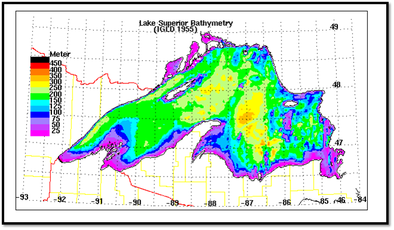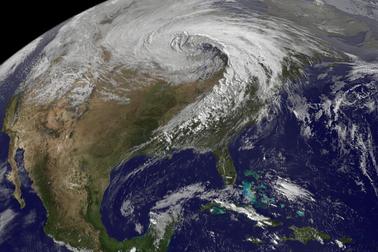Great Lakes' Vulnerability
To determine the vulnerability of the Great Lakes to meteotsunamis, we looked at the requirements for meteotsunamis to occur: resonance, meteorology and harbor amplification. To simplify, we only looked at Lake Superior and Lake Michigan for resonance and harbor characteristics.
Resonance
To determine the speeds of meteorologic disturbances necessary for meteotsunamis in Lakes Superior and Michigan, we looked at prevailing depths in both lakes to find which depths occur for long stretches in order for resonance to build up wave heights. We found that in Lake Michigan, the prevailing depths were between 50 and 100 m, which would result in wave speeds of 45 to 68 mph. In Lake Superior, we found prevailing depths of 200 to 250 m, which would result in wave speeds of 100 to 110 mph. These speeds will determine what types of meteorologic disturbances are necessary to create meteotsunamis in these lakes.
Meteorology
Knowing the speeds necessary for resonance over the two lakes, we looked at common meteorologic disturbances in the area to determine what types of events could lead to meteotsunamis. Cold fronts only travel at speeds around 12 mph, which are too slow. As mentioned in the History section, squall lines usually travel between 20 and 40 mph, but can reach speeds up to 70 mph. This is a resonant speed for Lake Michigan, which happened in 1954 and could happen again. In late October of 2010, an extreme storm reached speeds of 60-80 mph over Lake Superior, but even this extreme event is too slow for resonance over the deep Lake Superior (21). This could have caused resonance over Lake Michigan, however.
Harbor Amplification
After inspecting the coastlines of Lake Michigan and Lake Superior, there are few but not many harbors that may be susceptible to meteotsunamis. There are harbors in both lakes that are slender and have high Q-factors, but few that are actually open to where disturbances would come from. There are also jetties along the eastern coast of Lake Michigan, which could cause amplification of meteotsunami waves, as seen in similar historic events. In the end, we conclude that these jetties and harbors in southern Lake Michigan are most susceptible to meteotsunamis, but if extreme storm events happen over Lake Superior, there could be disastrous meteotsunamis in some harbors there.



